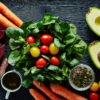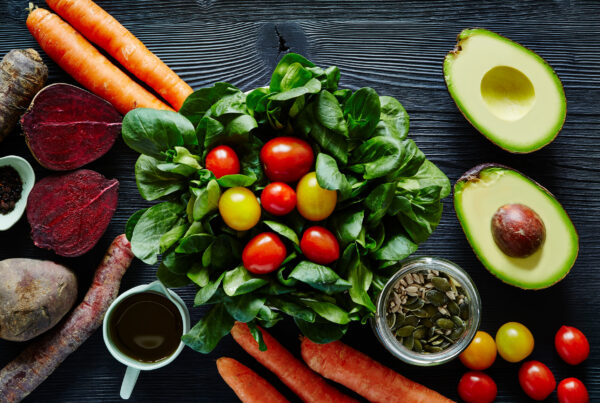”Question: I recently heard that skin is the largest organ of the body. How do I eat to nourish my skin?
Reading time: 12 Minutes
MWi Hack:
- Learn what foods can nourish your skin
- Get more educated on other skin problems that can be addressed with nutritional strategies
MWi Summary:
- While skin naturally ages, there are dietary choices that can help keep your skin healthy.
- Some nutrients that support skin health are beta-carotene, vitamin C, vitamin E, zinc, and selenium.
- Acne, psoriasis, and eczema symptoms can be alleviated through changes in your diet. It takes about six weeks to see changes.
Everyone has a favorite face cream or treatment, but beautiful skin starts with nourishment from within. Older cells are constantly shed and replaced by younger ones and a steady supply of key nutrients is essential to support this rapid growth. Eat the correct balance of foods and you’ll feed your skin the vital nutrients it needs to help it stay soft, supple, and blemish-free.
That said, as much as we may try to resist it, our skin does naturally age. Wrinkles and age spots are the inevitable result of time, but skin aging may be sped up by overexposure to the sun and tanning beds, strong soaps, chemicals, and poor nutrition. With this in mind, a holistic approach is best. Treat your skin kindly and optimize your nutrition by eating antioxidant-rich fruit and vegetables, healthy fats from oily fish and nuts, and a varied and balanced diet. This should give optimal levels of the nutrients that are crucial for radiant skin, including beta carotene, vitamins C and E, zinc, and selenium.
Read on for 11 top tips on eating your way to glowing skin…
1. Eat a minimum of five portions of fruit and vegetables every day
Fruit and vegetables contain powerful antioxidants that help to protect skin from the cellular damage caused by free radicals. Free radicals, smoking, pollution, and sunlight can cause wrinkling and age spots. Eat a rainbow of colorful fruit and vegetables and aim for at least five portions a day. Betacarotene, found in carrots, sweet potatoes and pumpkin, and lutein, found in kale, papaya, and spinach are potent antioxidants, important for normal skin cell development and healthy skin tone.
2. Eat enough vitamin C
Vitamin C is also a super antioxidant. It is needed to support the immune system, promote radiant skin and help blemishes heal properly. The best sources are blackcurrants, blueberries, broccoli, guava, kiwi fruits, oranges, papaya, strawberries, and sweet potatoes. Vitamin C is needed to produce collagen that strengthens the capillaries that supply the skin.
3. Don’t crash diet
Repeatedly losing and regaining weight can take its toll on your skin, causing sagging, wrinkles, and stretch marks. Crash diets are often short in essential vitamins and minerals too. Over long periods of time this type of dieting will reflect on your skin. It is always best to eat a healthy, balanced diet. If you’re considering trying a weight loss plan, make sure you have all the facts first – explore our expert guides to popular diets and read the six things you should consider before starting a diet.
4. Stock up on selenium
Selenium is a powerful antioxidant. It works alongside other antioxidants such as vitamins E and C and is essential to support the immune system. Studies suggest that a selenium-rich diet can help to protect against skin cancer, sun damage, and age spots. One way to boost your intake is to eat Brazil nuts. Just four nuts will provide the recommended daily amount (RDA). Mix Brazil nuts with other seeds rich in vitamin E as a snack or salad sprinkle. Other good sources are fish, shellfish, eggs, wheat germ, tomatoes, and broccoli.
5. Eat enough vitamin E
Vitamin E protects skin from oxidative (cell) damage and supports healthy skin growth. Foods high in vitamin E include almonds, avocado, hazelnuts, pine nuts, and sunflower and corn oils.
6. Drink six to eight glasses of water a day
Skin needs moisture to stay flexible. Even mild dehydration will cause your skin to look dry, tired, and slightly grey. Drink six to eight glasses of water a day – all fluids count towards your daily allowance, but water is the best. If you work in an office, keep a large bottle of water on your desk to remind you to drink. Herbal, caffeine-free teas are good too. Don’t forget that some fruit and vegetables, such as watermelon, courgette, and cucumber, also contribute fluids – the added benefit is that the minerals they contain will increase the rate you hydrate your body and skin. Try to avoid smoking and excessive alcohol consumption as both can age the skin.
7. Eat some healthy fat
Monounsaturated and polyunsaturated fats – the types found in avocados, oily fish, nuts, and seeds – provide essential fatty acids which act as a natural moisturizer for your skin, keeping it supple and improving elasticity. These fats also come packaged with a healthy dose of vitamin E (a vitamin many of us lack), which will help protect against free radical damage.
8. Opt for omega-3
Make sure you get enough omega-3 and omega-6 fats. These are essential fatty acids which mean they cannot be made in the body and must be obtained through the diet. You will find omega-3s in oily fish and plant sources such as linseed and their oil, chia seeds, walnuts, and rapeseed oil. Omega-3 fats encourage the body to produce anti-inflammatory compounds, which may help inflammatory skin conditions such as eczema and psoriasis.
9. Eat more phytoestrogens
Phyto-estrogens are natural chemicals found in plant foods (phyto from the Greek word for plant). They have a similar structure to the female sex hormone estrogen and have been found to help keep our natural hormones in balance. There are different types, some are found in soya bean products (isoflavones) such as tofu, whereas others are found in the fiber of whole grains, fruit, vegetables, and linseed (lignans). Include phyto-estrogen rich soya, whole grains, fruits, and vegetables as part of a balanced diet.
Find out more about the health benefits of soya.
10. Go for low-GI carbs
The glycaemic index (GI) is a system that ranks carbohydrate-based foods on how slowly or quickly they are broken down in the body into glucose. Try to eat plenty of beans, pulses, porridge, and other low-GI, slow-releasing carbohydrates. These release sugar into the bloodstream gradually, providing you with a steady supply of energy and leaving you feeling satisfied for longer and therefore less likely to snack. Avoid high-GI carbohydrates like biscuits and sugary drinks, as they lead to the production of insulin, which may damage collagen and accelerate wrinkles.
11. Eat plenty of zinc
Zinc is involved in the normal functioning of the sebaceous glands in the skin (which produce oil) and helps to repair skin damage and keep skin soft and supple. Zinc-rich foods include fish, lean red meat, whole grains, poultry, nuts, seeds, and shellfish.
Eat to beat common skin problems
Once you make changes to your diet, don’t expect an overnight miracle. It takes six weeks for new skin to emerge up to the surface, so the visible benefits from dietary changes will take just as long. For persistent skin conditions, talk to your GP or consider seeing a dermatologist.
How can diet affect acne?
Acne is caused by inflammation and infection of the sebaceous glands of the skin. Sebaceous glands are stimulated by hormones (particularly androgens). To avoid acne, cut back on saturated and hydrogenated fats in margarine and processed foods. Also cut down on junk food as well as foods high in sugar, such as cakes and biscuits. Eat more raw vegetables, whole grains, fresh fruit, and fish. Try to include selenium-rich foods, such as Brazil nuts, cashew nuts, fresh tuna, sunflower seeds, walnuts, and wholemeal bread.
How can diet affect psoriasis?
Psoriasis appears as red skin patches with silvery scales, most commonly on the elbows and knees. The patches are caused by the rapid growth and proliferation of cells in the outer skin layers. Patches can be itchy and sore and in severe cases, the skin may crack and bleed. Some people find outbreaks occur when they feel rundown. Sunburn, alcohol, smoking, obesity, and stress are also implicated and there may be trigger foods that you will have to identify using an exclusion diet, though always check with your GP before cutting out food groups. Essential fatty acids (EFAs) from fish oil or cold-pressed nut and seed oils are important to include in the diet. The diet should ideally be low in saturated fat and include anti-inflammatory herbs such as turmeric, red pepper, ginger, cumin, fennel, rosemary, and garlic.
How can diet affect eczema?
Eczema is a skin condition that usually begins as patchy redness, often on the hands but can appear anywhere on the skin. Although there are many triggers, one of the most common is food sensitivity. The most common offending foods are milk, eggs, fish, cheese, nuts, and food additives. Omega-3 fats, zinc, and vitamin E may help reduce symptoms.
MWi would like to thank Jo Lewin for sharing her expert insights with our community through the Goodfood platform. Read the original article:






